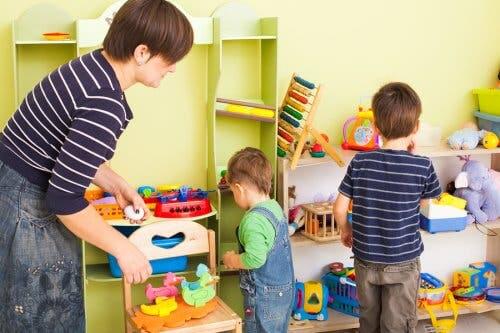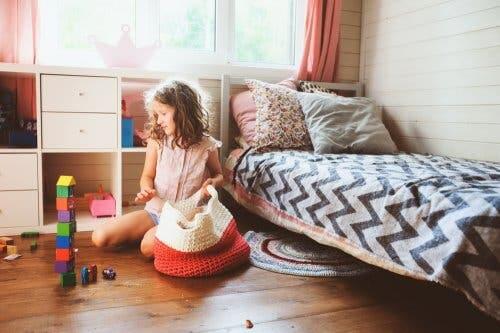The Importance of Teaching Children the Value of Order


Written and verified by the pedagogue and trainer María Matilde
How organized and orderly a person is doesn’t only have to do with their personality traits. It’s also a behavior that can be learned and practiced. Therefore, it’s something we can teach to our children, both at home and at school, to help them better handle their adult life. Today, we’ll talk about the importance of teaching children the value of order.
Being an orderly person
Order refers to the placement of people or things in a space, or the occurrence of events in time according to a rule or criteria. So then, an orderly person is one who obeys an order. Or, in other words, one who maintains order and a method in his or her actions.
Order is synonymous with organization and discipline. Therefore, an orderly person is capable of organizing, classifying, and arranging things in a meticulous and harmonious fashion. But, at the same time, orderly people are able to be disciplined and methodical in their conduct and thoughts. This allows them to carry out concrete activities in order to accomplish different objectives.
Of course, as long is it doesn’t become an obsession, order helps to make people more mature, responsible, conscious, and even freer. That’s because being an orderly and organized person in every area allows individuals to:

- Save time.
- Foresee problems.
- Keep worries, uncertainty, and anxiety under control.
- Experience less stress.
- Be more efficient and productive.
- Conserve energy.
- Gain emotional stability.
- Simplify their day-to-day tasks.
Teaching our children the value of order
It’s important to teach our children the value of order because, together with other values, it helps them solve problems more effectively. This not only applies to their present as children but also their future as adults.
Therefore, we shouldn’t teach children the value of order by imposition. Rather, through activities and routines that allow children to internalize order and organization. That way, they learn to see order as something natural and commonplace. What’s more, children will comprehend order as something that’s necessary in order to feel comfortable with themselves and the people around them.
We can make use of a variety of resources and school activity programs that allow us to meet the objective of teaching children the value of order.
Teaching our children the value of order entails:
- Establishing and respecting specific places where things belong both at school and at home. That way, once children finish an activity, they know where they should put away toys, materials, etc.
- Making putting things away fun. It’s important for children to feel like they’re still playing even when it’s time to tidy up. Therefore, when the time comes, you can use songs or games or associate the activity with other activities. For example, tidying up the classroom can be the last activity before lining up to say goodbye and go home.
- Involving your children in household tasks. This is an excellent way to teach them the value of order. This helps them establish their own routines and also adapt to the routines of your household. What’s more, they’ll learn a number of basic life skills, including making their beds, setting the table, folding clothes, brushing their teeth, etc.
- Learning to be orderly and organized should be an explicit objective when it comes to certain school activities. For example, organizing toys by size, shape, and color. Or, putting the toys and materials we like and use the most in a place that’s easy to reach.

Set a good example and give meaning to order and organization
It’s important for both teachers and parents to always be aware of the example we’re setting for our children. This is fundamental since children learn about everything through imitation. Therefore, each action regarding order and organization that parents perform has a great impact on the children that are watching.
What’s more, giving meaning to the task of putting things in order is also fundamental. That way, children understand that it’s not just a boring and senseless obligation. They need to feel like putting things away is in some way beneficial to them as well. Children must internalize the idea that being organized gives them more time and space to enjoy.
In short, both order and being an orderly person provide a sense of security. Just as organization guru Marie Kondo states in her book, “One of the magical effects of tidying is confidence in your decision-making capacity.”
How organized and orderly a person is doesn’t only have to do with their personality traits. It’s also a behavior that can be learned and practiced. Therefore, it’s something we can teach to our children, both at home and at school, to help them better handle their adult life. Today, we’ll talk about the importance of teaching children the value of order.
Being an orderly person
Order refers to the placement of people or things in a space, or the occurrence of events in time according to a rule or criteria. So then, an orderly person is one who obeys an order. Or, in other words, one who maintains order and a method in his or her actions.
Order is synonymous with organization and discipline. Therefore, an orderly person is capable of organizing, classifying, and arranging things in a meticulous and harmonious fashion. But, at the same time, orderly people are able to be disciplined and methodical in their conduct and thoughts. This allows them to carry out concrete activities in order to accomplish different objectives.
Of course, as long is it doesn’t become an obsession, order helps to make people more mature, responsible, conscious, and even freer. That’s because being an orderly and organized person in every area allows individuals to:

- Save time.
- Foresee problems.
- Keep worries, uncertainty, and anxiety under control.
- Experience less stress.
- Be more efficient and productive.
- Conserve energy.
- Gain emotional stability.
- Simplify their day-to-day tasks.
Teaching our children the value of order
It’s important to teach our children the value of order because, together with other values, it helps them solve problems more effectively. This not only applies to their present as children but also their future as adults.
Therefore, we shouldn’t teach children the value of order by imposition. Rather, through activities and routines that allow children to internalize order and organization. That way, they learn to see order as something natural and commonplace. What’s more, children will comprehend order as something that’s necessary in order to feel comfortable with themselves and the people around them.
We can make use of a variety of resources and school activity programs that allow us to meet the objective of teaching children the value of order.
Teaching our children the value of order entails:
- Establishing and respecting specific places where things belong both at school and at home. That way, once children finish an activity, they know where they should put away toys, materials, etc.
- Making putting things away fun. It’s important for children to feel like they’re still playing even when it’s time to tidy up. Therefore, when the time comes, you can use songs or games or associate the activity with other activities. For example, tidying up the classroom can be the last activity before lining up to say goodbye and go home.
- Involving your children in household tasks. This is an excellent way to teach them the value of order. This helps them establish their own routines and also adapt to the routines of your household. What’s more, they’ll learn a number of basic life skills, including making their beds, setting the table, folding clothes, brushing their teeth, etc.
- Learning to be orderly and organized should be an explicit objective when it comes to certain school activities. For example, organizing toys by size, shape, and color. Or, putting the toys and materials we like and use the most in a place that’s easy to reach.

Set a good example and give meaning to order and organization
It’s important for both teachers and parents to always be aware of the example we’re setting for our children. This is fundamental since children learn about everything through imitation. Therefore, each action regarding order and organization that parents perform has a great impact on the children that are watching.
What’s more, giving meaning to the task of putting things in order is also fundamental. That way, children understand that it’s not just a boring and senseless obligation. They need to feel like putting things away is in some way beneficial to them as well. Children must internalize the idea that being organized gives them more time and space to enjoy.
In short, both order and being an orderly person provide a sense of security. Just as organization guru Marie Kondo states in her book, “One of the magical effects of tidying is confidence in your decision-making capacity.”
All cited sources were thoroughly reviewed by our team to ensure their quality, reliability, currency, and validity. The bibliography of this article was considered reliable and of academic or scientific accuracy.
- Sanguineti, J. J. (1980). El concepto de orden. Sapientia (35). pp. 559-571. Recuperado de https://www.academia.edu/3878083/El_concepto_de_orden
- Kondo, M. (2015). La magia del orden. Editorial Aguilar. Madrid.
This text is provided for informational purposes only and does not replace consultation with a professional. If in doubt, consult your specialist.








